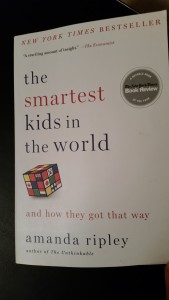What We Can Learn from Finland
My two favorite topics are fitness and education. On the surface they may not seem related, but the book I recently finished, The Smartest Kids in the World and How They Got That Way, by Amanda Ripley, offers insights that can be applied to both areas.
You might have heard that on an international critical thinking exam that tested math, science and reading, Finland, South Korea and Poland collectively kicked our American students’ asses. Ms. Ripley was on a quest to find how these countries transformed their public school systems, in a relatively short timeframe, to achieve this success. The answers she discovered mimic things I’ve noticed about fitness as well. With that in mind…
3 Things We Can Learn from Finland
Start with the best teachers
Sounds simple, doesn’t it? In Finland, a teaching degree comes from only the top schools and teachers specialize in the subject they plan to teach. Conversely, in America you can become a math teacher if you major in “education” and your primary goal is really to be a high school football coach.
In terms of fitness, you want the best coach for your sport, right? For example, I’ve had three trainers guide me through bodybuilding. All three of them competed and won or placed runner-up in multiple local, national and pro bodybuilding competitions. They fully understood the process of the show prep diet, posing techniques and specific strength training exercises to bring out each client’s best physique. A well meaning soccer coach might be enthusiastic and know the broad concepts, but not have the detailed information required to excel at a niche sport, so why would you hire a soccer coach if you are entering a figure competition?
Teachers in Finland have more respect than in America because both parents and students know how difficult it is to obtain certification. Since teachers have high credentials, it is assumed that they know what they are doing, so the government doesn’t require the plethora of tests that are required in the United States to prove it. Teachers in Finland have strong unions, salaries as high as other professionals, and greater autonomy to chose their own textbooks. They also produce academic powerhouse students ready for the 21st century economy.
Likewise, you can find any bargain-rate trainer on Craigslist, but the top trainers and coaches earn more and have client waitlists because they deliver results.
Failure is encouraged
The first time my trainer told me to do ‘push-ups to failure’ I was thoroughly confused. Why would I want to fail? Isn’t failure bad? He explained that doing an exercise to failure was the only way to test your limits and push past them. As it turns out, the best schools in the world promote failure as well.

In these top ranking countries, students are expected to fail and then learn from their mistakes. Classroom test results in some countries are read aloud or even posted on the walls for everyone to see, and guess what? No one died from embarrassment; they just worked harder to learn the subject matter.
In America, schools and politicians focus on self-esteem to a fault. I can remember going to an awards ceremony at my child’s school last year feeling very proud that she was awarded “Highest Honors”…until the list of students also receiving the award kept going and going until all but about four students were standing on the stage with her. If everyone is an A+ student, then the material is too easy. Sure, our kids might feel smart on that day, but what happens when they enter the job force? A boss won’t praise you just for showing up. And if you’ve never failed at anything before, how are you going to handle it when you bomb a major presentation at your first job?
Hard work trumps inclination
In America there is an idea that either you’re good at math naturally, or you’re not. This is not the case in the top scoring nations. Their understanding is that math is a difficult subject that every single student can learn (despite background, IQ, poverty level, parental involvement, etc.) with hard work and consistent effort. I can’t tell you what a relief that was to read. I was one of those kids who fell behind in math in the 3rd grade and never caught up. My daughter was falling into the same pattern as me and I heard her say, “I’m just not good at math.” In the past I probably would have agreed with her, but after reading this book I replied, “If poor immigrant kids can learn math in Poland, you can too. Just put in more effort!” And, miraculously, she did.

Likewise, my friend’s younger sister was dead last in ranking on her basketball team. The other girls at the start of the year had more speed and inborn talent. But my friend’s sister had something they lacked: grit. Every day after practice was over she ran sprints on her own and practiced shooting baskets. By the end of the year she was in the top tier, because hard work pays dividends.
South Korea places so much importance on academics that their children study 18 hours per day! Finnish and Polish students also study hard, but have a lot more balance in their lives. Although the time spend studying may be different lengths, all three countries and their citizens believe that education is to be taken seriously.
The same can be said of fitness. How many times have you gone to the gym to see people more focused on texting than lifting weights? Or have seen people in workout clothes holding a McDonald’s take-out bag? If you want serious results it requires serious effort.
Whether you are trying to improve your child’s education or your own physique, applying the above three rules will help you achieve the results you are seeking.
FYI – I have received no compensation for this post; this was just an interesting book I stumbled upon and wanted to share my thoughts about it.
Lisa ![]()
Lisa Traugott is a Mom’s Choice Award winning writer, fitness blogger, wife and mom of two. You can read more about her in her new book, “She’s Losing It!” available at Amazon.com.
ShesLosingIt.com (c) 2015 Lisa Traugott. All rights reserved. No portion of this blog, including any text, photographs, and artwork, may be reproduced or copied without written permission.
